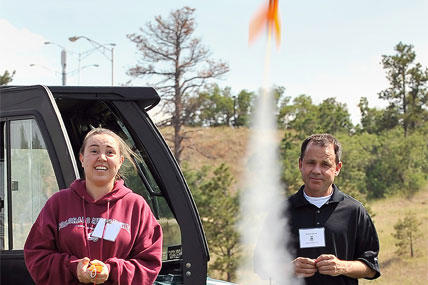U.S. AIR FORCE ACADEMY, Colo. -- The chair of the U.S. Air Force Academy's Engineering Division and head of the Aeronautics Department said the nation faces a crisis in the areas of science, technology, engineering and math.
To help avert the crisis, Col. Neal Barlow and other Academy officials are developing educational workshops for teachers such as the STEM boot camp held here July 11-13 and 16-18.
The Academy hosted its third STEM boot camp, divided into sessions for elementary, middle school and high school teachers. Ninety-eight teachers attended this year and were encouraged to become STEM enterprise managers at their schools.
Barlow said the percentage of college students who chose majors associated with STEM has dramatically decreased over the years and led to more wealth being produced overseas. In order to develop new technologies and new products, Barlow said kindergarten through 12th grade teachers play a critical role in the expansion of STEM students.
"The purpose is not only to bring together the curriculum and materials needed for effective STEM, but also the resources and partners in the community to effectively do STEM," said Billy Crisler, the assistant professor of aeronautics and director of the Academy's K-12 STEM Outreach Center.
The boot camp included projects on GPS use, rockets, space medicine, history and economics.
"The projects were related to cyber defense, marine engineering, robotics and aviation," Barlow said. "The first week was like a college course, to help teachers understand fundamentals of space and how you would use it in your classroom as a theme to teach everything. It's a lot of material, but it allows them to take a portion they're interested in and use it as a lesson plan."
Barlow said the Academy supports the Challenger Learning Center of Colorado to provide opportunities for teachers and students year-round in addition to the workshops.
"The center has a very robust, effective network throughout the Pikes Peak region with the local schools," Crisler said. "It's very easy for us to engage with them and we're able to execute what we want because they have such a great relationship with all of the school districts."
Crisler said when kids are doing STEM properly, it looks like chaos: It involves taking things apart, putting them back together, setting things on fire and breaking them.
"That's why engineering is different than basic science," Barlow said. "One of our challenges is most of our children are only introduced to math and science. They think all engineering is about is sitting in your cubicle all day and solving equations, but it's not.
"Engineering is producing things that have not existed before," the colonel said. "It certainly relies on math and science fundamentals, but it's about designing things, figuring out how to solve problems, leveraging new technologies as they emerge and developing other new ones."
Crisler said there is a distinction between the STEM academic mission to undergraduates here and K-12 STEM outreach.
"There are three different kinds of activities with STEM here," Crisler said. "There's the undergraduate education mission, outreach mission and this new institutional outreach to the community, where we're trying to be a partner with the rest of the community and solve this together."
Tracey Tomme, president and CEO of the Challenger Learning Center of Colorado, said the center closely evaluates teachers at boot camp.
"We take evaluation data on everything we do, because ultimately this is a research project and education research is always tricky," Tomme said. "We ask the teachers at the end of the boot camp what they got out of it and ask them about six months later how they're using things in the classroom. The goal is to get them interested, keep them interested and sustain it."
The STEM boot camp is only one component of the Academy's K-12 STEM outreach. Individual faculty and departments conduct a wide range of activities, such as the STEM Outreach Club created by cadets.
"In addition to going out to K-12 classrooms, interacting with students and judging science fairs, if you're somebody who needs a cadet to come and do something STEM-oriented, the club will send you someone," Barlow said. "This is done by the cadets with their desire to go out and be a part of that."
Barlow said those initiatives make an impact.
"Billy and I don't motivate kids like cadets do," Barlow said. "Cadets are very important to us."
Crisler said the next big step is the follow-up.
"We will know if we succeeded two or three years from now when we are having a conference where two dozen other communities and regions come to us and say, 'How did you do this?'" Crisler said. "We're investing in an infrastructure for these programs and the people who sponsor them to create and market these things nationally."
Representatives from New Mexico, Tennessee, California and Arizona attended the boot camp to observe and gather ideas for STEM outreach in their state.
Barlow said the hope is to solicit STEM interest, provide materials and help teachers institute age-appropriate and cognitive techniques that explore science and math.
"By the time students come out of middle school, they've not all decided for sure if they're going to be engineers or scientists, but most of them have decided they will not be," Barlow said. "If you're going to capture them in those areas, you've got to capture them during that time."






























